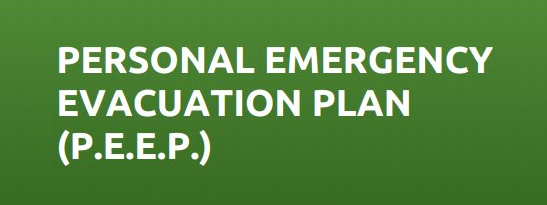What is a peep plan?
A Personal Emergency Evacuation Plan (PEEP) is a plan designed to assist individuals with disabilities or specific needs during an emergency evacuation. The purpose of a PEEP is to ensure that individuals who might have difficulty evacuating a building or a location due to their physical, sensory, or cognitive impairments are provided with appropriate support and guidance.

PEEPs are typically developed in workplaces, educational institutions, and other public spaces to ensure that everyone, including individuals with disabilities, can safely evacuate during emergencies such as fires, earthquakes, or other hazards. A PEEP takes into consideration the individual’s specific requirements and outlines the steps and procedures that should be taken to assist them during an evacuation. This might include details on how to alert the person, assign a designated helper, use specific evacuation routes or equipment, and any other accommodations necessary to ensure a safe evacuation.
Creating and implementing PEEPs is an important aspect of ensuring the accessibility and safety of all individuals in various settings. It’s essential to collaborate closely with the individuals involved to tailor the plan to their needs and regularly review and update the plan as necessary.
Please note that while I can provide general information about concepts like PEEPs, specific requirements and guidelines might vary depending on the jurisdiction, organization, or specific context. If you need to develop a PEEP or understand its specifics, I recommend consulting relevant local resources or authorities.
What should a peep plan contain?
A Personal Emergency Evacuation Plan (PEEP) should be tailored to the individual’s specific needs and circumstances. While the details of a PEEP can vary depending on the person’s disabilities, location, and available resources, here are some general elements that a PEEP might contain:
- Personal Information: Include the individual’s name, contact information, address, and any relevant medical or health information.
- Emergency Contacts: List names and contact information of people who should be notified in case of an emergency.
- Specific Needs: Clearly outline the person’s specific needs or disabilities that could impact their ability to evacuate safely. This might include mobility limitations, sensory impairments, cognitive disabilities, or any medical equipment they require.
- Communication: Describe the most effective way to communicate with the individual during an emergency. This could involve visual or tactile cues, written instructions, or specific communication devices.
- Designated Helper: Identify and assign a trained helper or “buddy” who is responsible for assisting the individual during an evacuation. Provide contact information for this helper.
- Evacuation Routes: Detail the safest and most accessible evacuation routes for the individual, taking into account any mobility challenges or sensory impairments.
- Assembly Points: Specify where the individual should go after evacuating the building or location. This could be a designated safe area where they can receive further assistance if needed.
- Alerting Mechanisms: Describe how the person will be alerted to an emergency situation, such as through visual or auditory alarms, text messages, or a designated helper.
- Assistive Devices: If the person uses any assistive devices such as wheelchairs, walkers, hearing aids, or communication aids, include information on how these will be managed during an evacuation.
- Training: Outline any training or orientation that the designated helper and other relevant staff members have received to assist the individual during an evacuation.
- Emergency Services Contact: Include emergency services contact information, such as local fire or medical services, as well as any additional resources that might be needed during an emergency.
- Regular Review: Emphasize the importance of regularly reviewing and updating the PEEP to ensure its accuracy and relevance.
Remember, the goal of a PEEP is to provide tailored guidance and support to individuals with disabilities or specific needs during an emergency evacuation. It’s important to involve the individual in the development of the plan and to work closely with relevant authorities or organizations to ensure that all necessary measures are taken to ensure their safety.
What are the two types of PEEP?
In the context of emergency preparedness and evacuation planning, there are typically two main types of Personal Emergency Evacuation Plans (PEEPs) that are considered:
- Generic PEEP (G-PEEP): A Generic PEEP is a standardized plan that outlines general evacuation procedures and accommodations for individuals with common types of disabilities or needs. This type of PEEP is often used when there are multiple individuals with similar requirements. For example, a Generic PEEP might be created for individuals who use wheelchairs, outlining the standard evacuation procedures, routes, and support mechanisms for wheelchair users.
- Individual PEEP (I-PEEP): An Individual PEEP is a customized plan that is tailored to the specific needs and circumstances of a single individual. It takes into account that person’s unique disabilities, medical conditions, mobility challenges, communication preferences, and other relevant factors. An Individual PEEP ensures that the person’s specific requirements are addressed during emergency evacuations.
Both types of PEEPs serve the purpose of ensuring that individuals with disabilities or special needs can evacuate safely during emergencies. While Generic PEEPs offer a standardized approach for groups of individuals with similar needs, Individual PEEPs provide a personalized and detailed plan for those with unique requirements. Organizations may use one or both types of PEEPs, depending on their resources, the diversity of their population, and the level of customization needed to ensure effective emergency preparedness.

Leave a comment